In Silico Prediction of the Dissociation Rate Constants of Small Chemical Ligands by 3D-Grid-Based VolSurf Method
Abstract
1. Introduction
2. Results and Discussions
2.1. Heat Shock Protein 90α
2.2. Adenosine Receptor
2.3. p38 Mitogen-Activated Protein Kinase
3. Methods
3.1. VolSurf
3.2. Partial Least Squares Regression
4. Conclusions
Supplementary Materials
Author Contributions
Funding
Conflicts of Interest
References
- De Benedetti, P.G.; Fanelli, F. Computational modeling approaches to quantitative structure-binding kinetics relationships in drug discovery. Drug Discov. Today 2018, 23, 1396–1406. [Google Scholar] [CrossRef] [PubMed]
- Copeland, R.A. Drug-target interaction kinetics: Underutilized in drug optimization? Future Med. Chem. 2016, 8, 2173–2175. [Google Scholar] [CrossRef] [PubMed]
- Schoop, A.; Dey, F. On-rate based optimization of structure-kinetic relationship--surfing the kinetic map. Drug Discov. Today Technol 2015, 17, 9–15. [Google Scholar] [CrossRef] [PubMed]
- Copeland, R.A.; Pompliano, D.L.; Meek, T.D. Drug-target residence time and its implications for lead optimization. Nat. Rev. Drug Discov. 2006, 5, 730–739. [Google Scholar] [CrossRef] [PubMed]
- Tummino, P.J.; Copeland, R.A. Residence time of receptor-ligand complexes and its effect on biological function. Biochemistry 2008, 47, 5481–5492. [Google Scholar] [CrossRef] [PubMed]
- Couffinhoarau, A.C.; Aubertin, A.M.; Boustta, M.; Schmidt, S.; Fehrentz, J.A.; Martinez, J.; Vert, M. Peptide−Poly(l-lysine citramide) Conjugates and their In Vitro Anti-HIV Behavior. Biomacromolecules 2009, 10, 865–876. [Google Scholar] [CrossRef]
- Delille, C.A.; Pruett, S.T.; Marconi, V.C.; Lennox, J.L.; Armstrong, W.S.; Arrendale, R.F.; Sheth, A.N.; Easley, K.A.; Acosta, E.P.; Vunnava, A.; et al. Effect of protein binding on unbound atazanavir and darunavir cerebrospinal fluid concentrations. J. Clin. Pharmacol. 2014, 54, 1063–1071. [Google Scholar] [CrossRef]
- Esseghaier, C.; Ng, A.; Zourob, M. A novel and rapid assay for HIV-1 protease detection using magnetic bead mediation. Biosens. Bioelectron. 2013, 41, 335–341. [Google Scholar] [CrossRef]
- Ershov, P.V.; Gnedenko, O.V.; Mol’nar, A.A.; Lisitsa, A.V.; Ivanov, A.S.; Archakov, A.I. Thermodynamic analysis of dimerization inhibitors binding to HIV protease monomers. Biomed. Khim 2012, 58, 43–49. [Google Scholar] [CrossRef]
- Kokh, D.B.; Amaral, M.; Bomke, J.; Grädler, U.; Musil, D.; Buchstaller, H.-P.; Dreyer, M.K.; Frech, M.; Lowinski, M.; Vallee, F.; et al. Estimation of Drug-Target Residence Times by τ-Random Acceleration Molecular Dynamics Simulations. J. Chem. Theory Comput. 2018, 14, 3859–3869. [Google Scholar] [CrossRef]
- Kokh, D.B.; Kaufmann, T.; Kister, B.; Wade, R.C. Machine Learning Analysis of τRAMD Trajectories to Decipher Molecular Determinants of Drug-Target Residence Times. Front. Mol. Biosci. 2019, 6, 36. [Google Scholar] [CrossRef] [PubMed]
- Ganotra, G.K.; Wade, R.C. Prediction of Drug-Target Binding Kinetics by Comparative Binding Energy Analysis. ACS Med. Chem. Lett. 2018, 9, 1134–1139. [Google Scholar] [CrossRef] [PubMed]
- Chiu, S.H.; Xie, L. Toward High-Throughput Predictive Modeling of Protein Binding/Unbinding Kinetics. J. Chem. Inf. Model. 2016, 56, 1164–1174. [Google Scholar] [CrossRef] [PubMed]
- Huang, S.H.; Zhang, D.; Mei, H.; Kevin, M.; Qu, S.J.; Pan, X.C.; Lu, L.C. SMD-Based Interaction-Energy Fingerprints Can Predict Accurately the Dissociation Rate Constants of HIV-1 Protease Inhibitors. J. Chem. Inf. Model. 2019, 59, 159–169. [Google Scholar] [CrossRef] [PubMed]
- Zhang, D.; Huang, S.; Mei, H.; Chen, L.; Kevin, M.; Shi, T. Protein–ligand interaction fingerprints for accurate prediction of dissociation rates of p38 MAPK Type II inhibitors. Integr. Biol. 2019, 11, 53–60. [Google Scholar] [CrossRef] [PubMed]
- Qu, S.J.; Huang, S.H.; Pang, X.C.; Yang, L.; Mei, H. Constructing Interconsistent, Reasonable, and Predictive Models for Both the Kinetic and Thermodynamic Properties of HIV-1 Protease Inhibitors. J. Chem. Inf. Model. 2016, 56, 2061–2068. [Google Scholar] [CrossRef] [PubMed]
- Pratt, W.B. The hsp90-based chaperone system: Involvement in signal transduction from a variety of hormone and growth factor receptors. Proc. Soc. Exp. Biol. Med. 1998, 217, 420–434. [Google Scholar] [CrossRef] [PubMed]
- Pearl, L.H.; Prodromou, C. Structure and in vivo function of Hsp90. Curr. Opin. Struct. Biol. 2000, 10, 46–51. [Google Scholar] [CrossRef]
- Kamal, A.; Thao, L.; Sensintaffar, J.; Zhang, L.; Boehm, M.F.; Fritz, L.C.; Burrows, F.J. A high-affinity conformation of Hsp90 confers tumour selectivity on Hsp90 inhibitors. Nature 2003, 425, 407–410. [Google Scholar] [CrossRef]
- Schuetz, D.A.; Richter, L.; Arnaral, M.; Grandits, M.; Gradler, U.; Musil, D.; Buchstaller, H.P.; Eggenweiler, H.M.; Frech, M.; Ecker, G.F. Ligand Desolvation Steers On-Rate and Impacts Drug Residence Time of Heat Shock Protein 90 (Hsp90) Inhibitors. J. Med. Chem. 2018, 61, 4397–4411. [Google Scholar] [CrossRef]
- Amaral, M.; Kokh, D.B.; Bomke, J.; Wegener, A.; Buchstaller, H.P.; Eggenweiler, H.M.; Matias, P.; Sirrenberg, C.; Wade, R.C.; Frech, M. Protein conformational flexibility modulates kinetics and thermodynamics of drug binding. Nat. Commun. 2017, 8, 2276. [Google Scholar] [CrossRef] [PubMed]
- Sheth, S.; Brito, R.; Mukherjea, D.; Rybak, L.P.; Ramkumar, V. Adenosine Receptors: Expression, Function and Regulation. Int. J. Mol. Sci. 2014, 15, 2024–2052. [Google Scholar] [CrossRef] [PubMed]
- Fredholm, B.B.; IJzerman, A.P.; Jacobson, K.A.; Linden, J.; Muller, C.E. International Union of Basic and Clinical Pharmacology. LXXXI. Nomenclature and Classification of Adenosine Receptors-An Update. Pharmacol. Rev. 2011, 63, 1–34. [Google Scholar] [CrossRef] [PubMed]
- Guo, D.; van Dorp, E.J.H.; Mulder-Krieger, T.; van Veldhoven, J.P.D.; Brussee, J.; IJzerman, A.P.; Heitman, L.H. Dual-Point Competition Association Assay: A Fast and High-Throughput Kinetic Screening Method for Assessing Ligand-Receptor Binding Kinetics. J Biomol. Screen 2013, 18, 309–320. [Google Scholar] [CrossRef]
- Louvel, J.; Guo, D.; Agliardi, M.; Mocking, T.A.M.; Kars, R.; Pham, T.P.; Xia, L.Z.; de Vries, H.; Brussee, J.; Heitman, L.H.; et al. Agonists for the Adenosine A(1) Receptor with Tunable Residence Time. A Case for Nonribose 4-Amino-6-aryl-5-cyano-2-thiopyrimidines. J. Med. Chem. 2014, 57, 3213–3222. [Google Scholar] [CrossRef]
- Louvel, J.; Guo, D.; Soethoudt, M.; Mocking, T.A.M.; Lenselink, E.B.; Mulder-Krieger, T.; Heitman, L.H.; Ijzerman, A.P. Structure-kinetics relationships of Capadenoson derivatives as adenosine A(1) receptor agonists. Eur. J. Med. Chem. 2015, 101, 681–691. [Google Scholar] [CrossRef]
- Xia, L.Z.; de Vries, H.; IJzerman, A.P.; Heitman, L.H. Scintillation proximity assay (SPA) as a new approach to determine a ligand’s kinetic profile. A case in point for the adenosine A(1) receptor. Purinerg Signal 2016, 12, 115–126. [Google Scholar] [CrossRef]
- Guo, D.; Heitman, L.H.; IJzerman, A.P. Kinetic Aspects of the Interaction between Ligand and G Protein-Coupled Receptor: The Case of the Adenosine Receptors. Chem. Rev. 2017, 117, 38–66. [Google Scholar] [CrossRef]
- Cuenda, A.; Rousseau, S. P38 MAP-Kinases pathway regulation, function and role in human diseases. Bba Mol. Cell Res. 2007, 1773, 1358–1375. [Google Scholar] [CrossRef]
- Thalhamer, T.; McGrath, M.A.; Harnett, M.M. MAPKs and their relevance to arthritis and inflammation. Rheumatology 2008, 47, 409–414. [Google Scholar] [CrossRef]
- Olson, J.M.; Hallahan, A.R. p38 MAP kinase: A convergence point in cancer therapy. Trends Mol. Med. 2004, 10, 125–129. [Google Scholar] [CrossRef] [PubMed]
- Thurmond, R.L.; Wadsworth, S.A.; Schafer, P.H.; Zivin, R.A.; Siekierka, J.J. Kinetics of small molecule inhibitor binding to p38 kinase. Eur. J. Biochem. 2001, 268, 5747–5754. [Google Scholar] [CrossRef] [PubMed]
- Regan, J.; Pargellis, C.A.; Cirillo, P.F.; Gilmore, T.; Hickey, E.R.; Peet, G.W.; Proto, A.; Swinamer, A.; Moss, N. The kinetics of binding to p38MAP kinase by analogues of BIRB 796. Bioorg. Med. Chem. Lett. 2003, 13, 3101–3104. [Google Scholar] [CrossRef]
- Millan, D.S.; Bunnage, M.E.; Burrows, J.L.; Butcher, K.J.; Dodd, P.G.; Evans, T.J.; Fairman, D.A.; Hughes, S.J.; Kilty, I.C.; Lemaitre, A.; et al. Design and Synthesis of Inhaled p38 Inhibitors for the Treatment of Chronic Obstructive Pulmonary Disease. J. Med. Chem. 2011, 54, 7797–7814. [Google Scholar] [CrossRef]
- Redhead, M.; Satchell, R.; Morkunaite, V.; Swift, D.; Petrauskas, V.; Golding, E.; Onions, S.; Matulis, D.; Unitt, J. A combinatorial biophysical approach; FTSA and SPR for identifying small molecule ligands and PAINs. Anal. Biochem. 2015, 479, 63–73. [Google Scholar] [CrossRef]
- Braka, A.; Garnier, N.; Bonnet, P.; Aci-Sèche, S. Residence Time Prediction of Type 1 and 2 Kinase Inhibitors from Unbinding Simulations. J. Chem. Inf. Model. 2020, 60, 342–348. [Google Scholar] [CrossRef]
- You, W.; Chang, C.-e.A. Role of Molecular Interactions and Protein Rearrangement in the Dissociation Kinetics of p38α MAP Kinase Type-I/II/III Inhibitors. J. Chem. Inf. Model. 2018, 58, 968–981. [Google Scholar] [CrossRef]
- Cruciani, C.; Crivori, P.; Carrupt, P.A.; Testa, B. Molecular fields in quantitative structure-permeation relationships: The VolSurf approach. J. Mol. Struct. Theochem. 2000, 503, 17–30. [Google Scholar] [CrossRef]
- Cruciani, G.; Pastor, M.; Guba, W. VolSurf: A new tool for the pharmacokinetic optimization of lead compounds. Eur. J. Pharm. Sci. 2000, 11, S29–S39. [Google Scholar] [CrossRef]
- Zamora, I.; Oprea, T.; Cruciani, G.; Pastor, M.; Ungell, A.L. Surface descriptors for protein-ligand affinity prediction. J. Med. Chem. 2003, 46, 25–33. [Google Scholar] [CrossRef]
- Tintori, C.; Magnani, M.; Schenone, S.; Botta, M. Docking, 3D-QSAR studies and in silico ADME prediction on c-Src tyrosine kinase inhibitors. Eur. J. Med. Chem. 2009, 44, 990–1000. [Google Scholar] [CrossRef] [PubMed]
- Ermondi, G.; Caron, G.; Pintos, I.G.; Gerbaldo, M.; Perez, M.; Perez, D.I.; Gandara, Z.; Martinez, A.; Gomez, G.; Fall, Y. An application of two MIFs-based tools (Volsurf plus and Pentacle) to binary QSAR: The case of a palinurin-related data set of non-ATP competitive Glycogen Synthase Kinase 3 beta (GSK-3 beta) inhibitors. Eur. J. Med. Chem. 2011, 46, 860–869. [Google Scholar] [CrossRef] [PubMed]
- Wold, S. Cross-Validatory Estimation of the Number of Components in Factor and Principal Components Models. Technometrics 1978, 20, 397–405. [Google Scholar] [CrossRef]
- Pearson, K. On lines and planes of closest fit to systems of points in space. Philos Mag. 1901, 2, 559–572. [Google Scholar] [CrossRef]
- Geladi, P.; Kowalski, B.R. Partial Least-Squares Regression: A Tutorial. Anal. Chim. Acta 1986, 185, 1–17. [Google Scholar] [CrossRef]
- Wold, S.; Sjostrom, M.; Eriksson, L. PLS-regression: A basic tool of chemometrics. Chemom. Intell. Lab. 2001, 58, 109–130. [Google Scholar] [CrossRef]
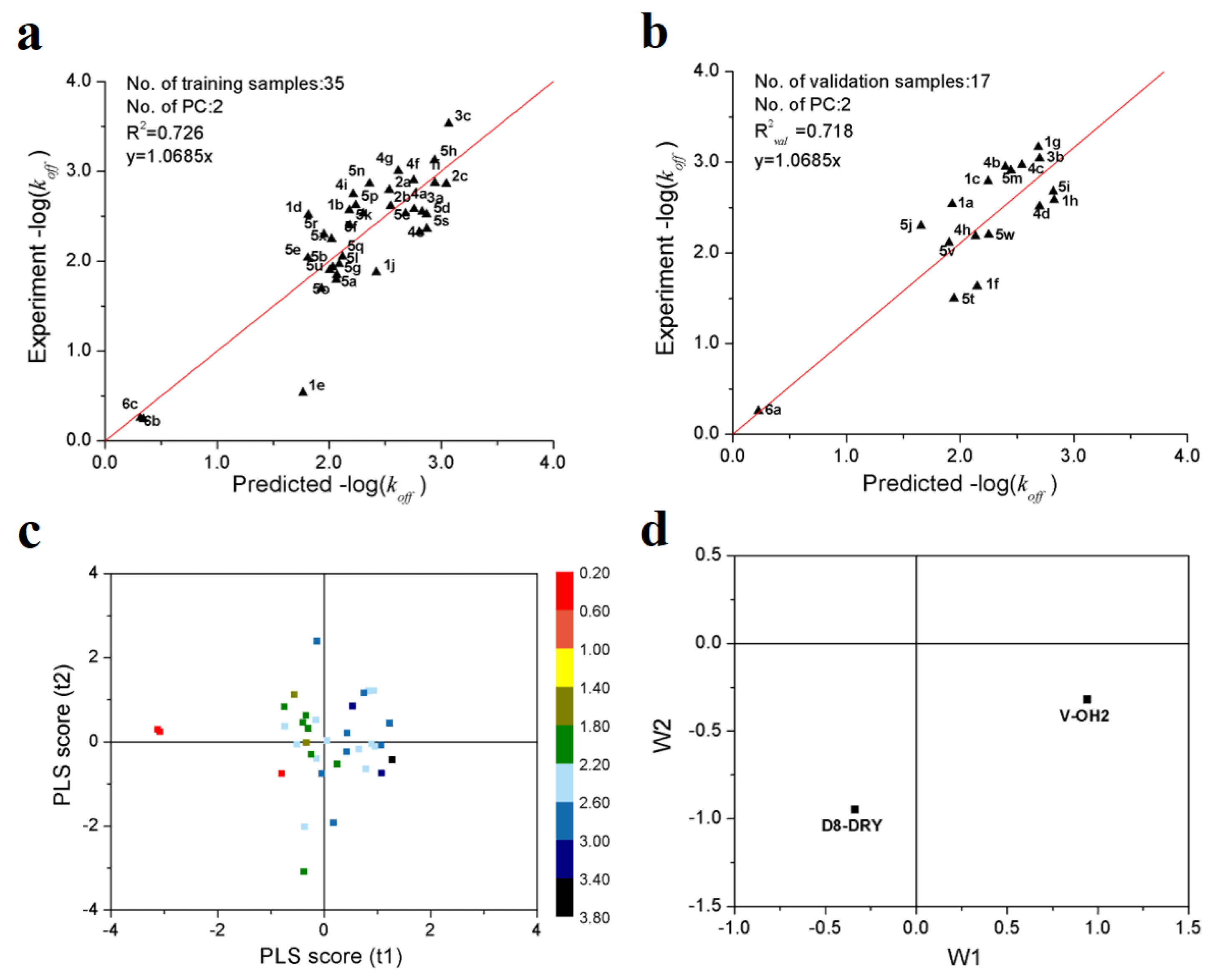


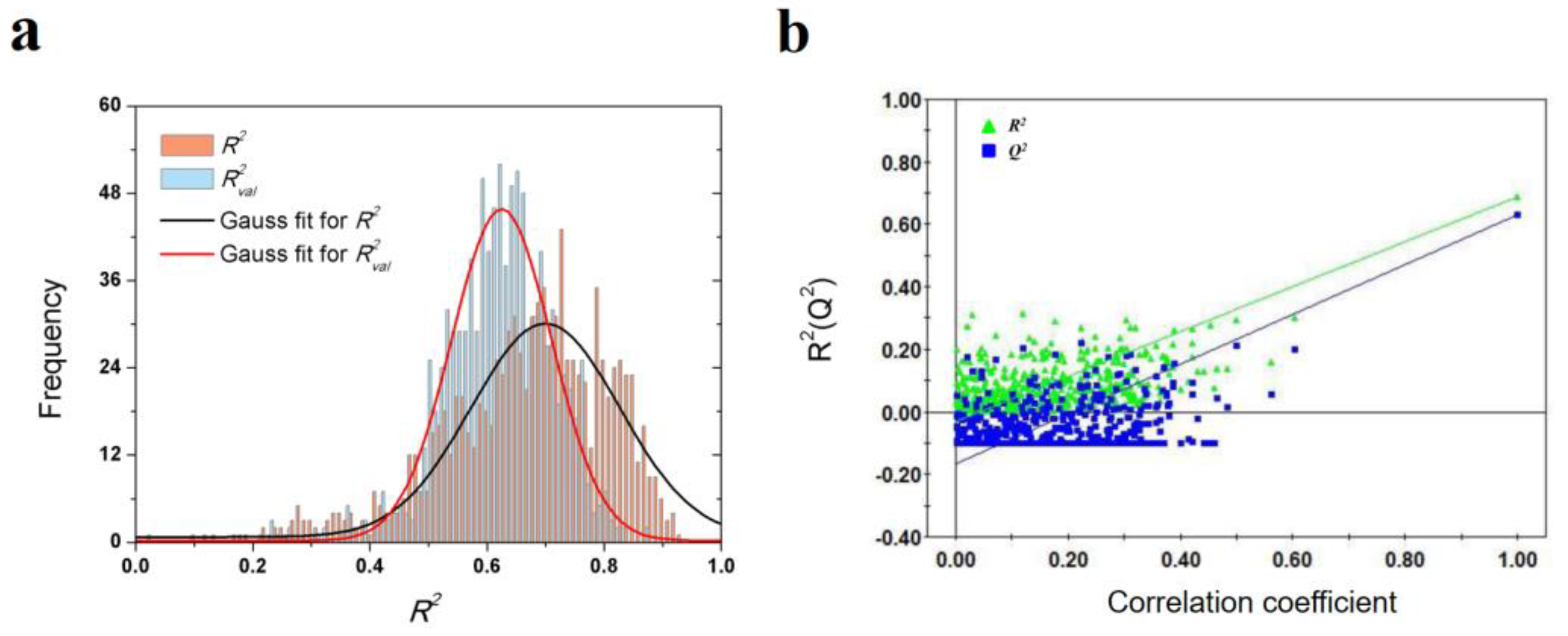
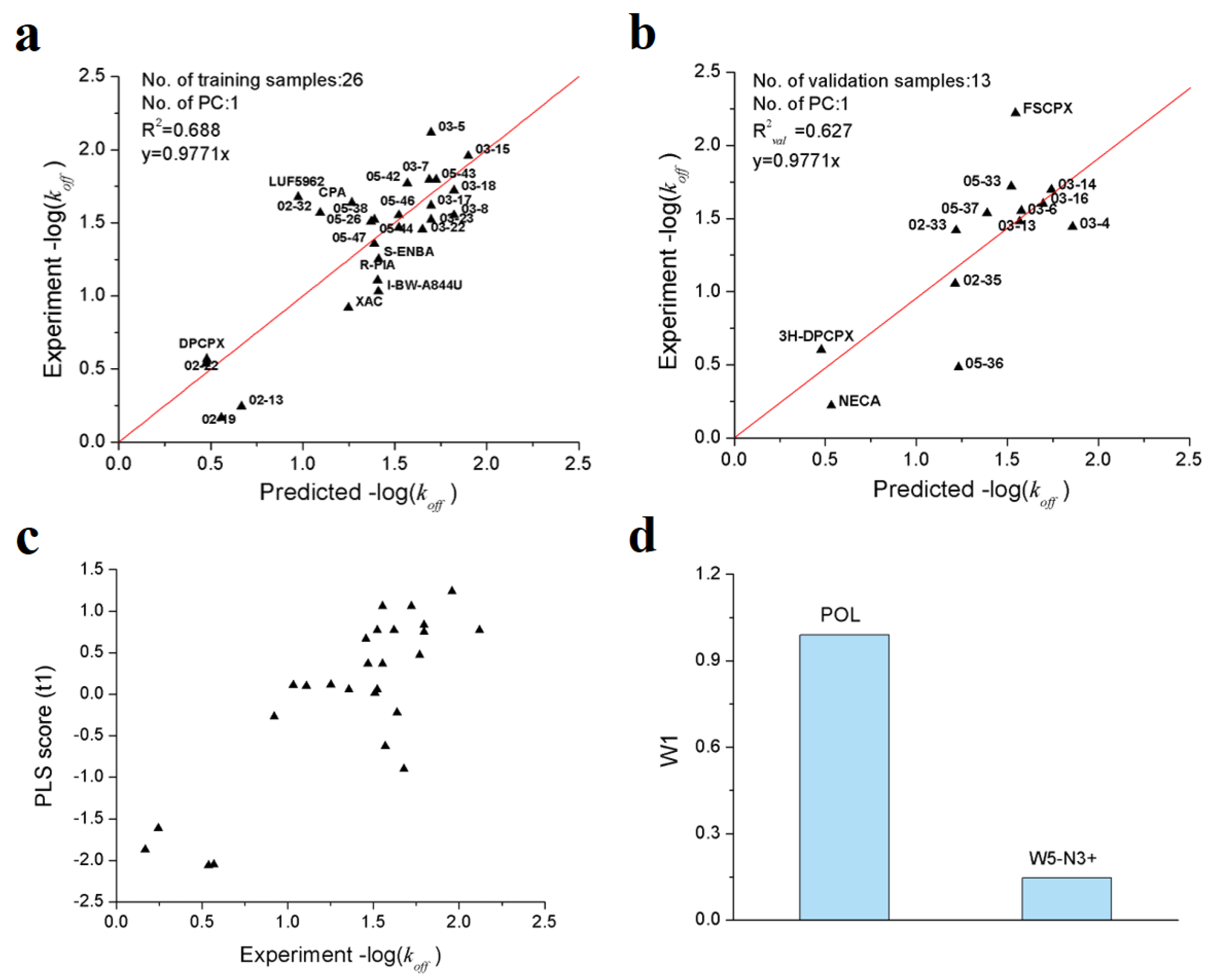
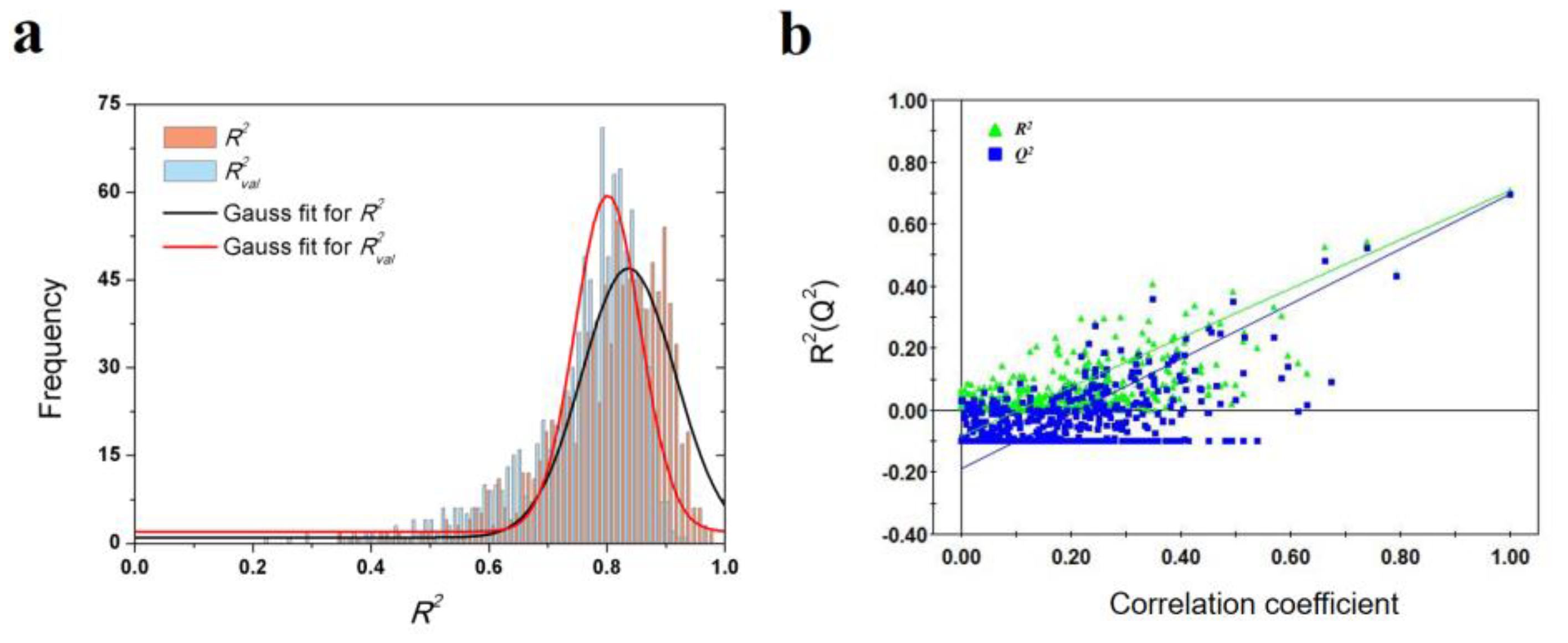
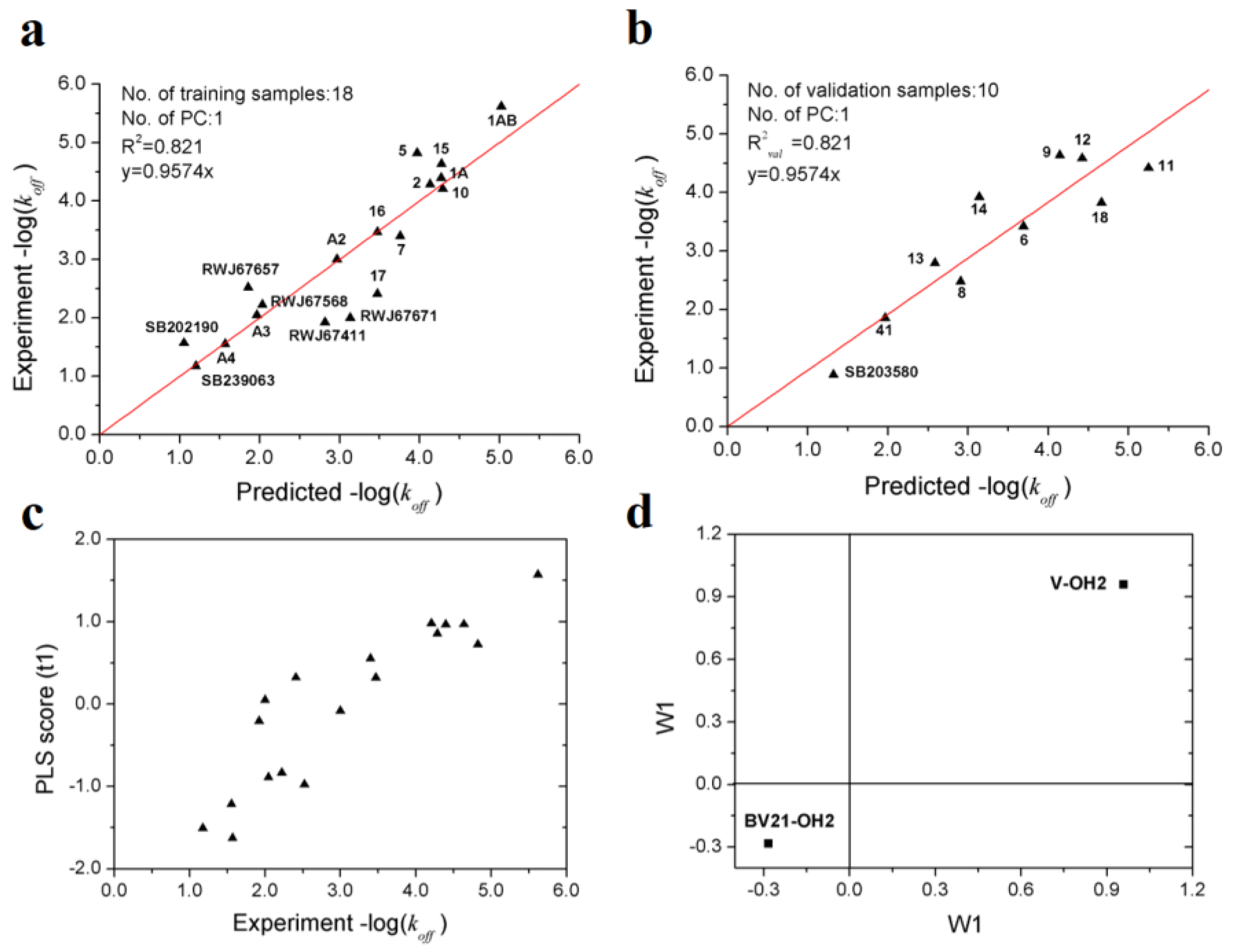
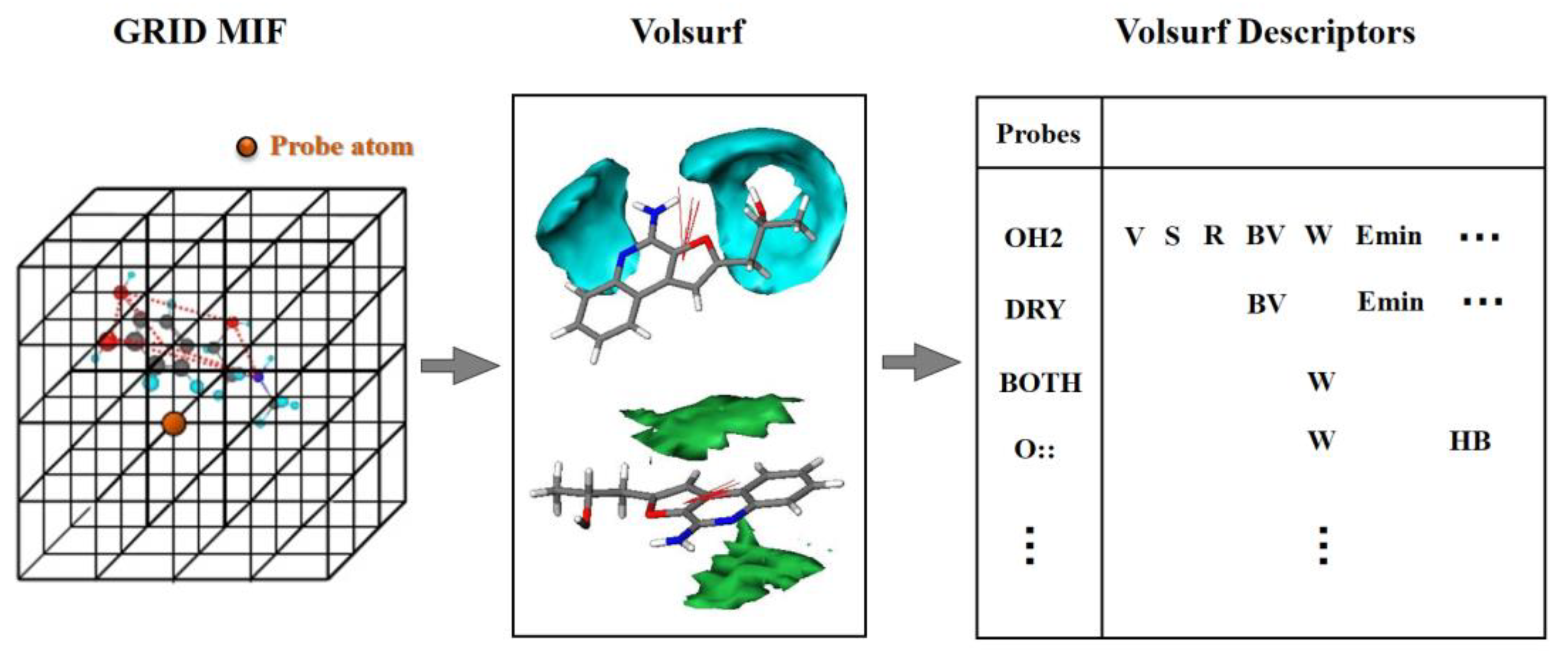
| Model | No. of Variables | Variables Involved in Sequence b | No. of PCs | R2 | Q2 c | RMSE d | MAPE e | R2val | RMSEP f | Equation |
|---|---|---|---|---|---|---|---|---|---|---|
| 1 | 1 | V-OH2 | 1 | 0.635 | 0.626 | 0.435 | 0.167 | 0.716 | 0.409 | Y = 1.0727X |
| 2 a | 2 | D8-DRY | 2 | 0.726 | 0.688 | 0.377 | 0.145 | 0.718 | 0.404 | Y = 1.0685X |
| 3 | 3 | W3-N3+ | 2 | 0.763 | 0.717 | 0.350 | 0.138 | 0.710 | 0.412 | Y = 1.073X |
| 4 | 4 | Emin1-OH2 | 2 | 0.771 | 0.709 | 0.345 | 0.128 | 0.744 | 0.393 | Y = 1.0753X |
| 5 | 5 | D4-DRY | 2 | 0.768 | 0.707 | 0.346 | 0.125 | 0.758 | 0.387 | Y = 1.0774X |
| 6 | 6 | A | 2 | 0.788 | 0.695 | 0.331 | 0.161 | 0.766 | 0.399 | Y = 1.0941X |
| 7 | 7 | IW8-OH2 | 2 | 0.815 | 0.726 | 0.310 | 0.186 | 0.780 | 0.393 | Y = 1.0968X |
| 8 | 8 | W4-N:= | 2 | 0.818 | 0.730 | 0.307 | 0.344 | 0.778 | 0.407 | Y = 1.1073X |
| 9 | 9 | D13-DRY | 2 | 0.819 | 0.658 | 0.306 | 0.143 | 0.730 | 0.437 | Y = 1.1101X |
| Model | Need to Consider Receptors? | No. of Variables | Total Sample Size | Training/Validation/Test Samples | R2 | Q2 | MAPE | R2val | R2test |
|---|---|---|---|---|---|---|---|---|---|
| VolSurf | No | 2 | 101 | 35/17/49 | 0.73 | 0.69 a | 0.15 | 0.72 | 0.56 |
| τRAMD [10] | Yes | NA | 70c | 59/0/0 | 0.66 | NA | NA | NA | NA |
| τRAMD [11] | Yes | NA | 94d | 80/0/0 | 0.75 | NA | 0.39 | NA | NA |
| COMBINE [12] | Yes | 42 | 70 e | 53/13/0 | 0.80 | 0.69 b | 0.37 | 0.86 | NA |
| Model | No. of Variables | Variables Involved in Sequence b | No. of PCs | R2 | Q2 c | RMSE | MAPE | R2val | RMSEP | Equation |
|---|---|---|---|---|---|---|---|---|---|---|
| 1 | 1 | POL | 1 | 0.638 | 0.606 | 0.299 | 0.201 | 0.584 | 0.341 | Y = 0.9691X |
| 2 a | 2 | W5-N3+ | 1 | 0.688 | 0.631 | 0.278 | 0.201 | 0.627 | 0.284 | Y = 0.9771X |
| 3 | 3 | W2-O | 2 | 0.644 | 0.549 | 0.297 | 0.197 | 0.581 | 0.290 | Y = 0.9873X |
| 4 | 4 | Emin2-DRY | 2 | 0.678 | 0.599 | 0.282 | 0.193 | 0.489 | 0.311 | Y = 0.9814X |
| 5 | 5 | D13-OH2 | 2 | 0.717 | 0.623 | 0.264 | 0.185 | 0.561 | 0.277 | Y = 0.9912X |
| 6 | 6 | BV21-DRY | 2 | 0.757 | 0.610 | 0.245 | 0.165 | 0.579 | 0.279 | Y = 0.9934X |
| 7 | 7 | ID1-DRY | 2 | 0.762 | 0.600 | 0.242 | 0.150 | 0.647 | 0.257 | Y = 1.0237X |
| Model | No. of Variables | Variables Involved in Sequence b | No. of PCs | R2 | Q2 c | RMSE | MAPE | R2val | RMSEP | Equation |
|---|---|---|---|---|---|---|---|---|---|---|
| 1 | 1 | V-OH2 | 1 | 0.709 | 0.696 | 0.696 | 0.192 | 0.685 | 0.671 | Y = 0.9862X |
| 2 a | 2 | BV21-OH2 | 1 | 0.821 | 0.818 | 0.546 | 0.145 | 0.821 | 0.527 | Y = 0.9574X |
| 3 | 3 | IW3-OH2 | 1 | 0.881 | 0.882 | 0.445 | 0.122 | 0.713 | 0.683 | Y = 0.9344X |
| 4 | 4 | Emin1-OH2 | 1 | 0.877 | 0.856 | 0.453 | 0.159 | 0.604 | 0.765 | Y = 0.9579X |
| 5 | 5 | W8 | 1 | 0.821 | 0.808 | 0.546 | 0.160 | 0.628 | 0.727 | Y = 0.993X |
| 6 | 6 | D7-DRY | 1 | 0.868 | 0.827 | 0.469 | 0.130 | 0.567 | 0.800 | Y = 0.9561X |
| 7 | 7 | D6-DRY | 1 | 0.853 | 0.760 | 0.465 | 0.135 | 0.481 | 0.905 | Y = 0.9224X |
| 8 | 8 | W8-O | 1 | 0.846 | 0.751 | 0.506 | 0.138 | 0.484 | 0.895 | Y = 0.9282X |
| 9 | 9 | IW7-OH2 | 1 | 0.859 | 0.756 | 0.485 | 0.125 | 0.490 | 0.905 | Y = 0.9167X |
| Model | Need to Consider Receptors? | No. of Variables | Total Sample Size | Training/Validation Samples | R2 | Q2 | R2val |
|---|---|---|---|---|---|---|---|
| VolSurf | No | 2 | 28 | 18/10 | 0.82 | 0.82 a | 0.82 |
| Position-restrained MD [15] | Yes | 3 | 20 | 14/6 | 0.72 | 0.66 b | 0.56 |
| Biased MD [36] | Yes | NA | 8 | 8/0 | 0.64 | NA | NA |
© 2020 by the authors. Licensee MDPI, Basel, Switzerland. This article is an open access article distributed under the terms and conditions of the Creative Commons Attribution (CC BY) license (http://creativecommons.org/licenses/by/4.0/).
Share and Cite
Huang, S.; Chen, L.; Mei, H.; Zhang, D.; Shi, T.; Kuang, Z.; Heng, Y.; Xu, L.; Pan, X. In Silico Prediction of the Dissociation Rate Constants of Small Chemical Ligands by 3D-Grid-Based VolSurf Method. Int. J. Mol. Sci. 2020, 21, 2456. https://doi.org/10.3390/ijms21072456
Huang S, Chen L, Mei H, Zhang D, Shi T, Kuang Z, Heng Y, Xu L, Pan X. In Silico Prediction of the Dissociation Rate Constants of Small Chemical Ligands by 3D-Grid-Based VolSurf Method. International Journal of Molecular Sciences. 2020; 21(7):2456. https://doi.org/10.3390/ijms21072456
Chicago/Turabian StyleHuang, Shuheng, Linxin Chen, Hu Mei, Duo Zhang, Tingting Shi, Zuyin Kuang, Yu Heng, Lei Xu, and Xianchao Pan. 2020. "In Silico Prediction of the Dissociation Rate Constants of Small Chemical Ligands by 3D-Grid-Based VolSurf Method" International Journal of Molecular Sciences 21, no. 7: 2456. https://doi.org/10.3390/ijms21072456
APA StyleHuang, S., Chen, L., Mei, H., Zhang, D., Shi, T., Kuang, Z., Heng, Y., Xu, L., & Pan, X. (2020). In Silico Prediction of the Dissociation Rate Constants of Small Chemical Ligands by 3D-Grid-Based VolSurf Method. International Journal of Molecular Sciences, 21(7), 2456. https://doi.org/10.3390/ijms21072456




